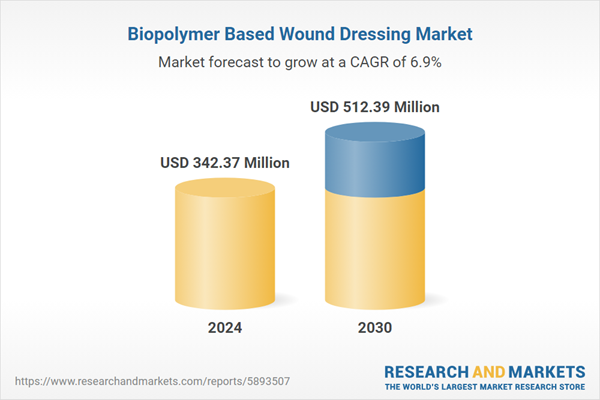Speak directly to the analyst to clarify any post sales queries you may have.
10% Free customizationThis report comes with 10% free customization, enabling you to add data that meets your specific business needs.
With growing demand for advanced wound care, biopolymer-based solutions are increasingly used to manage chronic wounds, burns, surgical incisions, and traumatic injuries. The surge in chronic diseases, aging populations, and the global emphasis on better wound management are significant growth factors. These dressings provide advantages such as infection control, moisture retention, and enhanced healing, all while improving patient comfort. The market is marked by continuous innovation, regulatory focus on safety and efficacy, and strategic partnerships aiming to strengthen market presence and meet the evolving needs of modern wound care.
Key Market Drivers
Rising Prevalence of Chronic Wounds
The growing number of chronic wounds is a major factor fueling the Global Biopolymer Based Wound Dressing Market. Conditions like diabetic foot ulcers, venous leg ulcers, and pressure sores present long-term healing challenges and often require specialized care. According to the International Diabetes Federation's 2024 report, nearly one in ten adults worldwide now lives with diabetes, significantly contributing to chronic wound prevalence. Addressing these wounds demands advanced and prolonged care approaches that improve healing outcomes and reduce complications.Biopolymer-based dressings, composed of materials like chitosan, alginate, and collagen, offer essential properties such as moisture balance and antibacterial effects. Clinical evidence, including a 2023 study in Advances in Wound Care, has shown that these dressings can shorten healing times for diabetic foot ulcers by over 30% compared to traditional options. Their ability to support tissue repair and manage infection makes them well-suited for treating chronic wounds effectively.
Key Market Challenges
Limited Clinical Evidence
A key challenge hindering the growth of the Global Biopolymer Based Wound Dressing Market is the limited availability of strong clinical evidence. While early research and anecdotal results suggest notable benefits, a lack of comprehensive clinical trials restricts the full endorsement of these products by healthcare professionals and regulatory authorities. Clinical validation is essential to confirm safety, performance, and cost-effectiveness, particularly in areas such as healing time, infection control, and patient comfort. However, producing this evidence involves significant investment, complex study designs, and coordination among manufacturers, researchers, and healthcare providers. Without large-scale, long-term studies, confidence in biopolymer-based wound dressings remains limited, delaying market expansion and broader adoption.Key Market Trends
Personalized Wound Care Solutions
A leading trend in the Global Biopolymer Based Wound Dressing Market is the emergence of personalized wound care solutions tailored to individual patient needs. This approach recognizes that wounds differ in size, depth, exudate levels, and healing rates, and therefore require customized treatment strategies. Biopolymer-based dressings offer the flexibility to meet these needs by regulating moisture, enabling oxygen exchange, and incorporating targeted therapeutic agents. Advances in material science and manufacturing now allow for precise engineering of dressings to address specific wound profiles. Healthcare providers can select dressings based on patient-specific factors, enhancing healing efficiency and minimizing complications. This shift toward individualized wound management reflects a broader movement in healthcare toward patient-centric solutions.Key Market Players
- HemCon Medical Technologies, Inc.
- 3M Company
- Integra LifeSciences Corporation
- ConvaTec Group PLC
- Smith & Nephew plc
- Advancis Medical
- Coloplast A/S
- Lohmann & Rauscher GmbH & Co KG
- Sorbsan
- KiBou Pharma
Report Scope:
In this report, the Global Biopolymer Based Wound Dressing Market has been segmented into the following categories, in addition to the industry trends which have also been detailed below:Biopolymer Based Wound Dressing Market, By Type:
- Chitin
- Chitosan
- Sodium Alginate
- Calcium Alginate
- Others
Biopolymer Based Wound Dressing Market, By Application:
- Burns
- Ulcers
- Cuts and Lacerations
- Others
Biopolymer Based Wound Dressing Market, By End User:
- Hospitals
- Ambulatory Surgery Center
- Others
Biopolymer Based Wound Dressing Market, By region:
- North America
- United States
- Canada
- Mexico
- Asia-Pacific
- China
- India
- South Korea
- Australia
- Japan
- Europe
- Germany
- France
- United Kingdom
- Spain
- Italy
- South America
- Brazil
- Argentina
- Colombia
- Middle East & Africa
- South Africa
- Saudi Arabia
- UAE
Competitive Landscape
Company Profiles: Detailed analysis of the major companies present in the Global Biopolymer Based Wound Dressing Market.Available Customizations:
With the given market data, the publisher offers customizations according to a company's specific needs. The following customization options are available for the report.Company Information
- Detailed analysis and profiling of additional market players (up to five).
This product will be delivered within 1-3 business days.
Table of Contents
Companies Mentioned
- HemCon Medical Technologies, Inc.,
- 3M Company
- Integra LifeSciences Corporation
- ConvaTec Group PLC
- Smith & Nephew plc
- Advancis Medical
- Coloplast A/S
- Lohmann & Rauscher GmbH & Co KG
- Sorbsan
- KiBou Pharma
Table Information
| Report Attribute | Details |
|---|---|
| No. of Pages | 187 |
| Published | June 2025 |
| Forecast Period | 2024 - 2030 |
| Estimated Market Value ( USD | $ 342.37 Million |
| Forecasted Market Value ( USD | $ 512.39 Million |
| Compound Annual Growth Rate | 6.9% |
| Regions Covered | Global |
| No. of Companies Mentioned | 10 |









